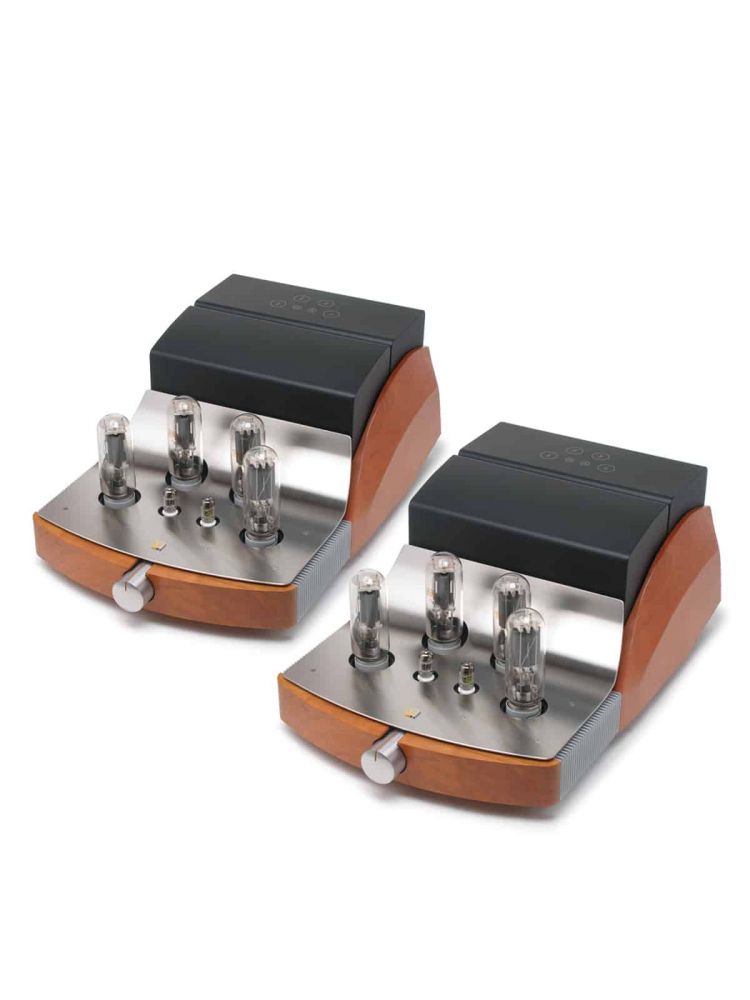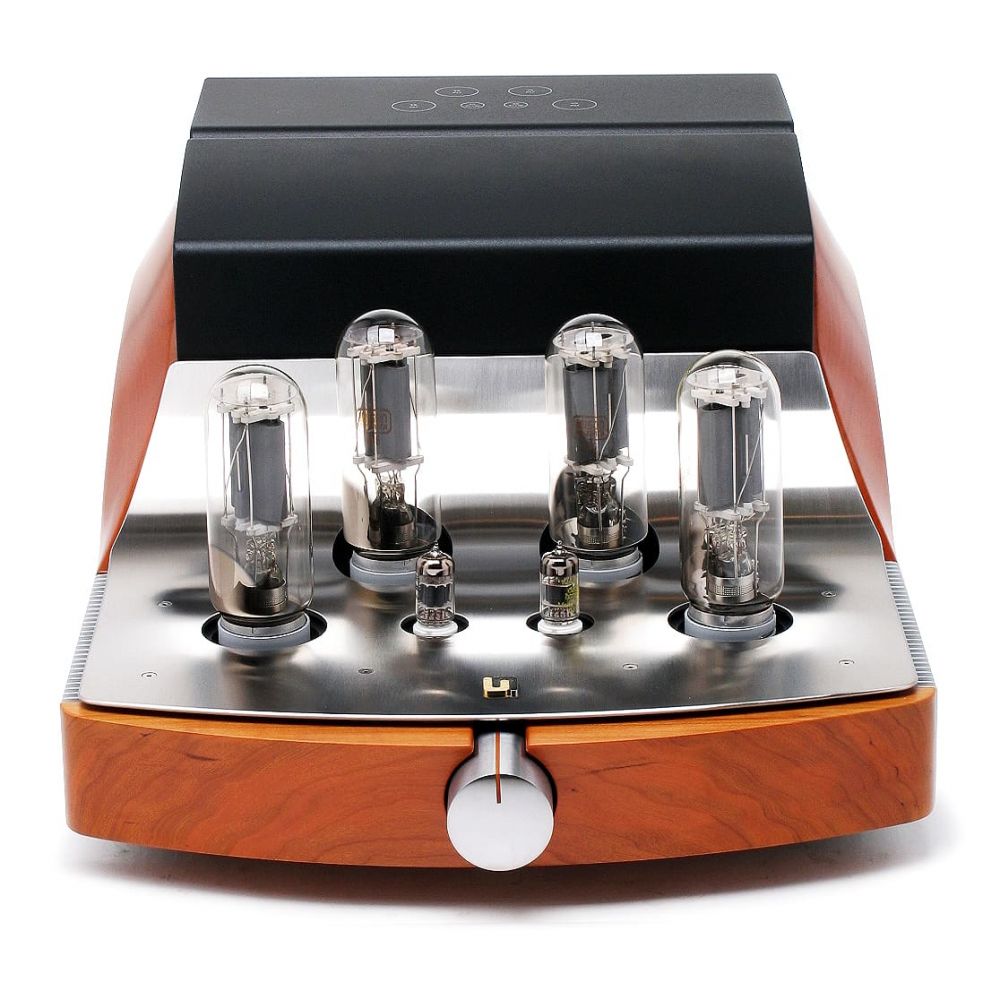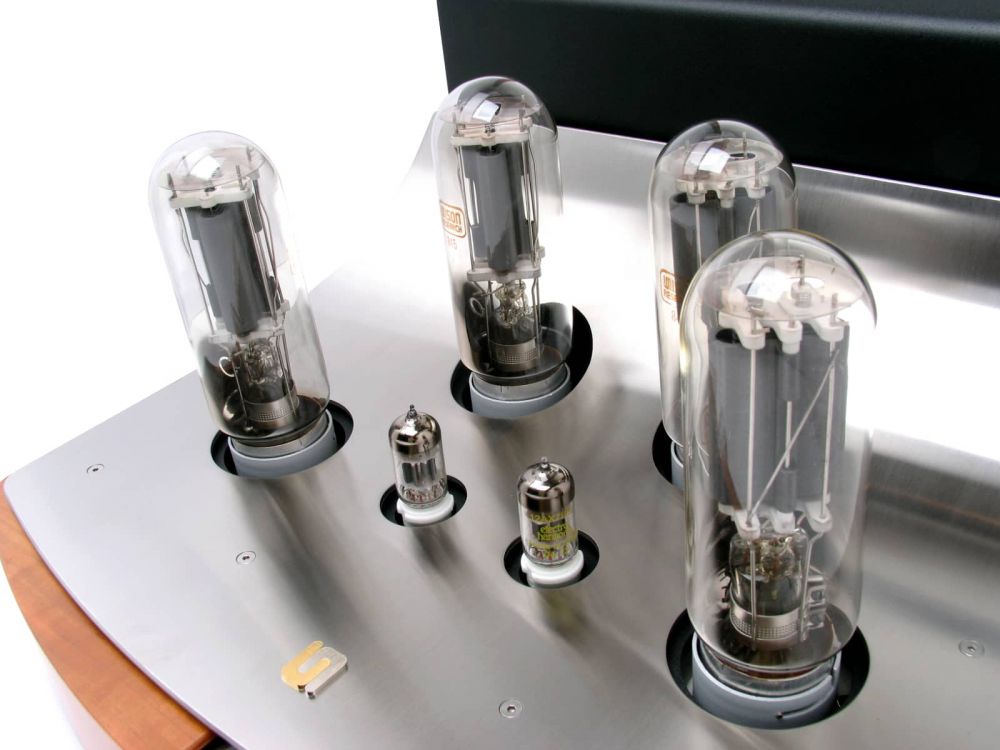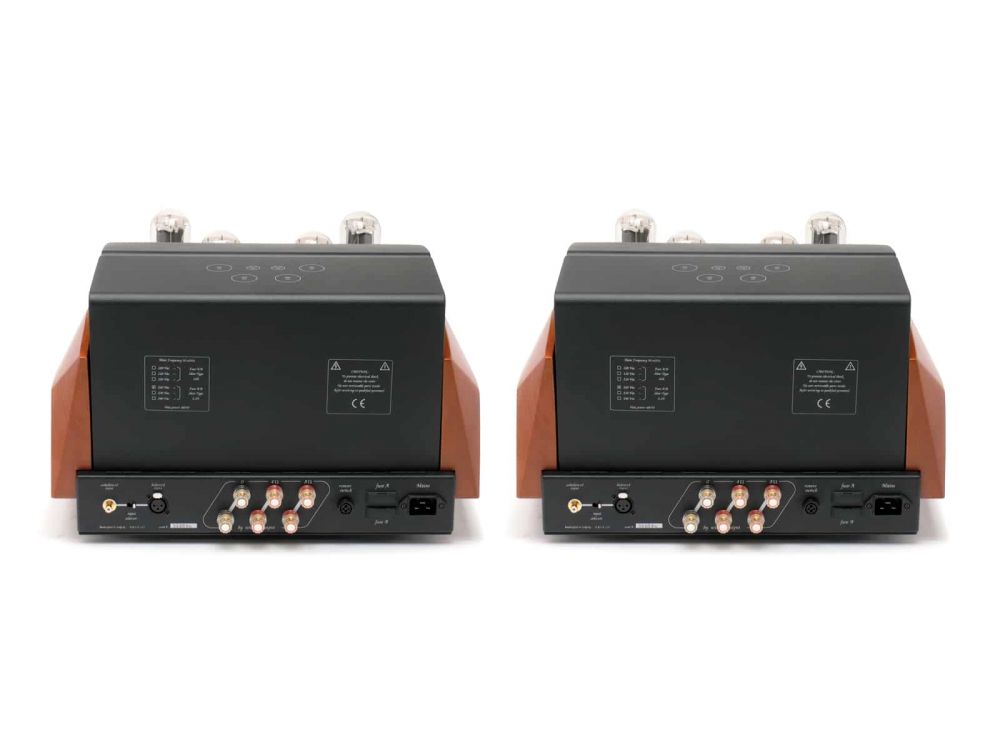- You do not have any products in your shopping cart yet.








Unison Research REFERENCE MONO Valve Power Amplifier
UNISON RESEARCH REFERENCE MONO, Double Parallel Single-Ended Pure-Class 'A' Mono Valve Power Amplifier.
Description
Many customers, already familiar with our the current products, have expressed the desire to see a new model in the catalogue: an all-tube, pure Class-A power amplifier, with a power output much higher than anything so far seen from Unison Research.
With the aim of satisfying this requirement, the Unison Research team began to evaluate the possibility of producing an amplifier which would incorporate the best learned from many years of experience with valve amplifiers.
The idea was certainly an ambitious one: to design a single-ended amplifier with twice the output power of the most powerful product in the catalogue, and truly worthy of inclusion amongst models that have made the Unison famous throughout the world..
Such a demanding product brief, to be developed entirely by the Unison team, necessarily implied multiple choices and led finally to the realisation of a separate monoblock pair of amplifiers.
First to be outlined was the structure of the single amplifier: an input stage based upon the twin triode ECC82 used as a voltage amplifier; followed by a driver stage again using a twin triode ECC82, biased in such a way as to be able to adequately drive four directly-heated 845 triode valves; and two very large output transformers working in parallel. Finally, the whole amplifier should have a minimum amount of feedback.
The 845 valve was chosen in this project first and foremost for its renowned sound quality, but also because it is a recognisable symbol used in many historical products from Unison Research, including the famous ABSOLUTE 845.
Once decided the structure of the amplifier, the next real challenge was to design the power supply system. In order to provide a power supply appropriate to an amplifier of this level, each monoblock has two 400-watt mains transformers with a total of 16 secondary windings. The anode voltage for bias control of the four 845 valves comes from a power supply stage able to guarantee a regulated supply at 900V. The regulation circuit uses 4 power MOSFETS, and completely eliminates any residual AC component which may be present in the rectifier circuit in a more efficient way than even a high value inductance filter can achieve.
Each power triode has its own DC heater supply taken from a separate transformer winding. This ensures that there will be no interference between the four triodes and any AC component present in the mains supply.
The bias system for the triodes is also fully independent for each valve, in order to compensate for whatever changes take place in the characteristics of each one during its lifetime, and which may vary from valve to valve. Four independent circuits regulate the four grid voltages to maintain an optimal level of anode current for each triode.
Many other details were considered during the design stage of this project. Each separate function of the amplifier was given its own independent printed circuit. The input terminals are fully gold-plated and those for the outputs, as well as being gold-plated are more than adequately specified to cope with the high power available from this amplifier. The cover uses a stainless steel screen of amegnetic material and low thermic conduction to ensure that the heat generated by the four 845 valves does not affect the underlying circuitry. This measure is intended to guarantee good stability, sound quality and reliability of the whole amplifier. The wood parts are also beneficial in helping to damp out resonance in the metal chassis and in fact drastically reduce the possibility of microphonic effect in the input stage.
As can be readily appreciated, the Unison Research tradition of great care and attention to every aspect of design has been fully upheld in this project, and this famous Italian company can proudly add yet another milestone in audio amplification to its catalogue. .
Technical Description
As mentioned above, the Reference project began with a definition of the outline scheme. Being a
power amplifier, the first question was to decide on the required output power; 80 watts from a quartet of 845 triodes in parallel, a level roughly double that of the most powerful amplifiers in the Unison Research catalogue. This requirement also dictated the choice of a two chassis solution, as a monoblock amplifier pair. The obvious advantage of this solution lies in the maximum separation between channels, but equally important was the need to keep the size and weight of each to a manageable level.
The next step was to define the circuit. In view of the limited amplification required from one power amplifier, maximum power is obtained with 1 volt (rms) at the input. Considering also the small amount of feedback typical of a Unison Research amplifier, the choice fell to a first stage consisting of two twin-triode ECC82s. The two triodes in a single valve operate in parallel giving reduced anode impedance which helps to give wide bandwidth, good driving ability, and distorsion and noise levels which are generally reduced. The first pair of triodes in parallel is used for voltage amplification of the input signal, which is passed on to the second stage. This too consists of a pair of ECC82 triodes in parallel but this time the triode bias has greater current to enable these valves to act as drivers for the power triodes. A power supply of around 600V allows this stage to have an adequate voltage swing. The output from the driver stage feeds the four grids of the 845 triodes, whose anode current in turn feeds two output transformers working in parallel.
Manufacturing output transformers of this size is certainly not an easy matter and must be undertaken with great care as well as strict adherence to criteria which have been learned at Unison Research through many years of valuable design and production experience. From the very beginning in fact, Unison Research has dedicated itself to the design, development and manufacture of output transformers, certain in the knowledge that good sound reproduction from valve amplifiers is highly dependent on the quality of these critical components which few manufacturers in the world are capable of designing and building. Thanks to specially made output transformers it has been possible to produce for the Reference an output stage consisting of four 845 valves in parallel single-ended configuration.
In building an output stage consisting of triodes in parallel however, careful selection and matching of the valves themselves is of paramount importance. But this only partially solves the need to have homogenous characteristics because with the passage of time the ageing process causes non-uniform changes in the valves, and in consequence an eventual unbalance in the output stage, with power loss and an increase in the level of harmonic distorsion. By carefully this problem, we have been able to create in our own laboratory a special electronic circuit which acts on the bias of each individual power valve, making continuous adjustments for those parameters which are subject to drift, and thereby continually optimises the working state of the valves themselves. This allows the valves to continue giving their maximum sound quality even after many years of use. One incidental benefit from this circuit is that the warm-up time between switch-on and best performance from the amplifier is appreciably reduced. Each triode is mounted on a ceramic base beneath which is situated the printed circuit for control of individual bias, which it carries out by monitoring the anode current value and power supply to the filament.
Each amplification stage is entrusted exclusively to valves, and all operate in pure class A. Negative feedback is returned to the cathode of the first valve, and its value (approx. 8dB) was chosen after rigorous experimental tests and especially by many hours of listening tests in a variety of situations.
Just as for the bias control circuit described above, each amplifier function is given its own separate
printed circuit. There are eleven such boards for each amplifier.
The anode power supply for the power triodes is regulated at 900V by a circuit expressly designed for this amplifier. Four power MOSFETs, a double bank of capacitors and a total of four separate windings divided between the two transformers form a system for anode voltage regulation similar to that provided by a battery; its benefits are a total absence of residual undulation, low output impedance and high current supply capacity.
The problem of power supply for the Reference was studied at great length to establish the possibility of providing an anode supply similar to what might be obtained from of a bank of batteries. After much research and experimentation we were able to come up with a valid solution. The MOSFET stage is used to separate the rectified voltage of the four secondary windings from the power supply voltage for the output stage anode tension. Its job is to regulate the filter capacitor load current, which is therefore fully continuous and not impulsive as in traditional rectification systems. One further significant advantage is that the output capacity of the power supply is now used exclusively for signal amplification components, having totally eliminated those associated with rectification. The result is effectively a multiplication of the total filter capacity. In this way the anode supply developed for the Reference can be considered to have a capacity far greater than any normal power supply, able moreover to behave like a real battery, something that would be impracticable for an amplifier of this power rating.
The two power supply transformers in each Reference monoblock are not normal transformers but are designed and made to the same standard and the same materials as we use for output transformers. This is not only as a guarantee of reliability but more especially to allow the amplifying stages to operate in ideal working conditions. It is important to remember that the energy that flows from the loudspeakers is supplied by the amplifier`s power transformers. The transformers moreover have no less than 16 secondary windings in order to supply every one of the amplifier`s active components, thus drastically reducing the phenomenon of interaction. Both driver and amplification valve filaments are supplied with dc current. The power valves on the other hand require a significantly greater heater power and are therefore provided with dc via a rectification stage from an independent winding. The rectification circuits include shottky diodes which are more efficient and less noisy that traditional rectifiers commonly used in other applications.
Each amplifier is equipped with six large gold-plated output terminals able to accept every type of loudspeaker cable, and allowing connection in bi-wiring for both 4 and 8 ohm loads. The input connection is also of best quality and fully gold-plated.
The front-mounted power-on switch does not act directly on the mains supply, but commands a system of two power relays, one for each mains transformer. These relays, placed close to the power transformers enable the internal mains cabling to be as short as possible so as to avoid the presence of mains borne disturbances affecting the delicate amplifying stages.
In the Reference nothing has been left to chance; from the choice of components, the control knobs and the wood parts to the design of the chassis and the circuit boards.
The power-on switch is machined from amagnetic stainless steel. The wood parts, which have the obvious and important function of visual appearance, also play another carefully calculated role – that of damping out induced resonance in the metal chassis. Valves are microphically sensitive electronic components, therefore care taken in this aspect of design can prevent resonance-generated signal disturbance with clear benefits to sound quality.
The cover consists of an amagnetic stainless-steel screen having low heat conductance, to ensure that the heat generated by the four 845 valves does not reach the underlying circuitry. The benefits of this are realised in greater stability and sound quality as well as better long-term reliability.
Indeed, to ensure the best performance and reliability, all the components used in the Reference have been carefully selected; from the non-inductive filter capacitors supplied by the Italian ITALCOND and German SIEMENS companies, from the pure ceramic valve bases to the printed circuits in extra-thick vetronite. The cabling is carried out with high-quality wire. Even the dimensions of the circuit boards and placement and size of ventilation holes has been carefully calculated to ensure that internal heat build-up does not occur, again in the interests of reliability.
The circuit boards have been designed with extreme care taken over signal and power supply paths and their relative thicknesses. All earth tracks are star wired and the signal paths are widely spaced, again in the quest for maximum separation and therefore minimum interference between signals.All of this and much else besides comes from Unison Reserach`s many years of experience, and is your guarantee that this new Reference is a power amplifier of superb performance, and the pride of our current production.
Technical characteristics
- Type: Mono Valve Amplifier
- Output Stage: double parallel single-ended
- Classe: A pure
- Valves: 4 x 845, 1 x ECC82, 1 x ECC83
- Output Power: 100 watt
- Frequency Response: 20 Hz – 30 kHz
- Feedback factor: 14 dB
- Output Impedance: 4 Ohm e 8 Ohm
- Outputs: loudspeakers bi-wiring
- Inputs: 1 x RCA , 1 x XLR
- Input Impedance: 47 kOhm RCA , 10 kOhm XLR
- Power Consumption: 400 VA approx.
- Dimensioni (mm.): 19.3” x 30.5” x 11.2” (w x d x h)
- Net Weight: 155 lbs
- Consumer Information :
-
Manufacturer InformationUnison Research
Via Barone 4
31030 Dosson di Casier
Treviso, Italy
Tel: +39 0422 633547
Web: https://unisonresearch.com/en/
Distributor in Germany (EU)
TAD-Audiovertrieb GmbH
Warnings and information
Hallwanger Str. 14
83209 Prien am Chiemsee
E-mail: hifi@tad-audiovertrieb.de
Web: https://tad-audiovertrieb.de
Tel: +49 (0) 8052 9573273
We currently have no safety information or warnings from the manufacturer.
Customer reviews
Unfortunately there are no reviews yet. Be the first who rates this product.
For more information, please visit the home page for this product.





.jpg)